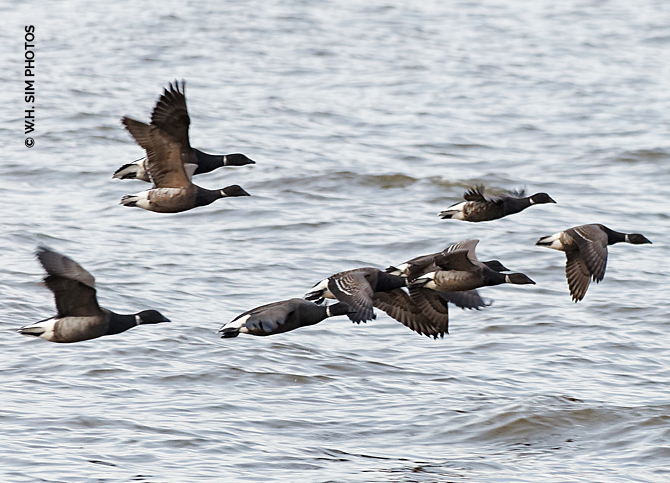This gallery contains 3 photos. While considered a fairly cosmopolitan species, these dainty geese are usually sighted in Metro Vancouver in small flocks during the colder months of the year. They tend to keep to themselves, even when large flocks of overwintering ducks like Mallards, American Wigeons, and Northern Pintails are in the same area. They’re easily recognizable from great distances, thanks to their distinctive white collars, and distinguishable from the similarly-sized Cackling Geese, and much larger and more ubiquitous Canada Geese. The subspecies we see here in the Pacific Northwest is the Black Brant (or Pacific Brant), with darker bellies than those Brants found along the Atlantic coast.
 A flock of Brant, harried into flight by a Bald Eagle on November 25
A flock of Brant, harried into flight by a Bald Eagle on November 25
f/8, 1/320, 500mm, ISO 640
Brant geese are also known as Brent geese in Europe. Brant look very much like Barnacle geese (which we don’t get here in the Pacific Northwest). But, where Brants are ground nesters in the high Arctic1, Barnacle geese–to avoid predators–nest on towering cliffs (and their newly hatched young have to make death-defying leaps, hundreds of feet to the ground to search for food2).

One of two Brant geese snacking on seaweed on the ice on December 14
f/8, 1/1250, 500mm, ISO 1250
In mid-December 2016, thanks to the Polar Vortex sweeping through many parts of North America, the outer waters of Boundary Bay Regional Park froze, with only a few channels closer to the trail that were clear of ice. Temperatures dipped to -8 C for almost a week! Under these unseasonably cold conditions, we saw birds we normally don’t see close to shore, close to shore, like Brant geese.

The ice makes all of us walk like penguins on December 14
f/6.3, 1/400, 500mm, ISO 200
These sub-zero temperatures made footing difficult for even the usual winter birds. More than once, they would slip and fall (like me at the skating rink), but would promptly pick themselves up again and continue their trek. They’re real troopers! Boundary Bay Regional Park gives these vegetarians access to copious amounts of food. Learn more about Brant geese by visiting their Cornell Lab of Ornithology allaboutbirds.org profile here.
SOURCES:
1 Brant Life History (Cornell Lab of Ornithology allaboutbirds.org)
2 Life Story Episode 1: First Steps (BBC Natural History Unit)
MY ZAZZLE WEBSITE www.zazzle.com/walkswithnature
ON FACEBOOK www.facebook.com/whsimphotography
ON TWITTER www.twitter.com/whuisim
ON GOOGLE+ plus.google.com/u/0/+WHSIM

The wordpress reader chopped your wonderful photo in half! https://cindyknoke.com/2016/12/15/changes-to-wp-reader/
LikeLiked by 1 person
thanks for the update, Cindy!
LikeLike
Thanks for great photographs.
LikeLiked by 1 person
Handsome characters. Do people feed them when the weather gets this cold – or break holes in the ice for them to swim?
LikeLiked by 2 people
in my admittedly limited experience with Brants, I do not think so. Brants are not as bold as Canada Geese, which will sometimes be aggressive and demand to be fed. they are quite self-sufficient characters, though. and a handsome amount of kelp/seagrass gets washed up on the (higher) shores and manages to avoid being frozen … easy pickings!
if the local waters ice over, they’ll just waddle over the ice. I saw this yesterday with 60-80 American Wigeons at the local pond (cum skating rink). 🙂
LikeLike
They are beautiful Brant Geese.
Thank you for these great photos
I wish you a good weekend.
LikeLiked by 1 person
thank you, Hervé! have a great weekend.
LikeLiked by 1 person
Nice post! Love the flight shot. Here is a link to my Brant post. These photos were taken in New Jersey. The fascinating thing for me is the colour difference between the west, and east coast Brant: https://incidentalnaturalist.com/2015/09/16/brant-geese/
LikeLiked by 1 person
Thanks, David! 🙂
Great to read your post about the Atlantic Brant. Really nice closeups of your subjects, too–you’re lucky to see many more Brants than we tend to over in the Pacific Northwest. Our flocks are much smaller, much more wary around humans. It looks to me like the main difference is the belly color, but the collar also seems to be less ornate, for the lack of a better word, with the East Coast Brants?
Cheers,
Hui
LikeLiked by 1 person
Beautiful birds .. and real troopers 😃
LikeLiked by 1 person
thanks, Julie! the snow and ice finally melted yesterday, and I saw 50-60 Brants in the far distance (where they tend to be). the extreme cold brings the more unusual birds closer to us. 🙂
LikeLiked by 1 person